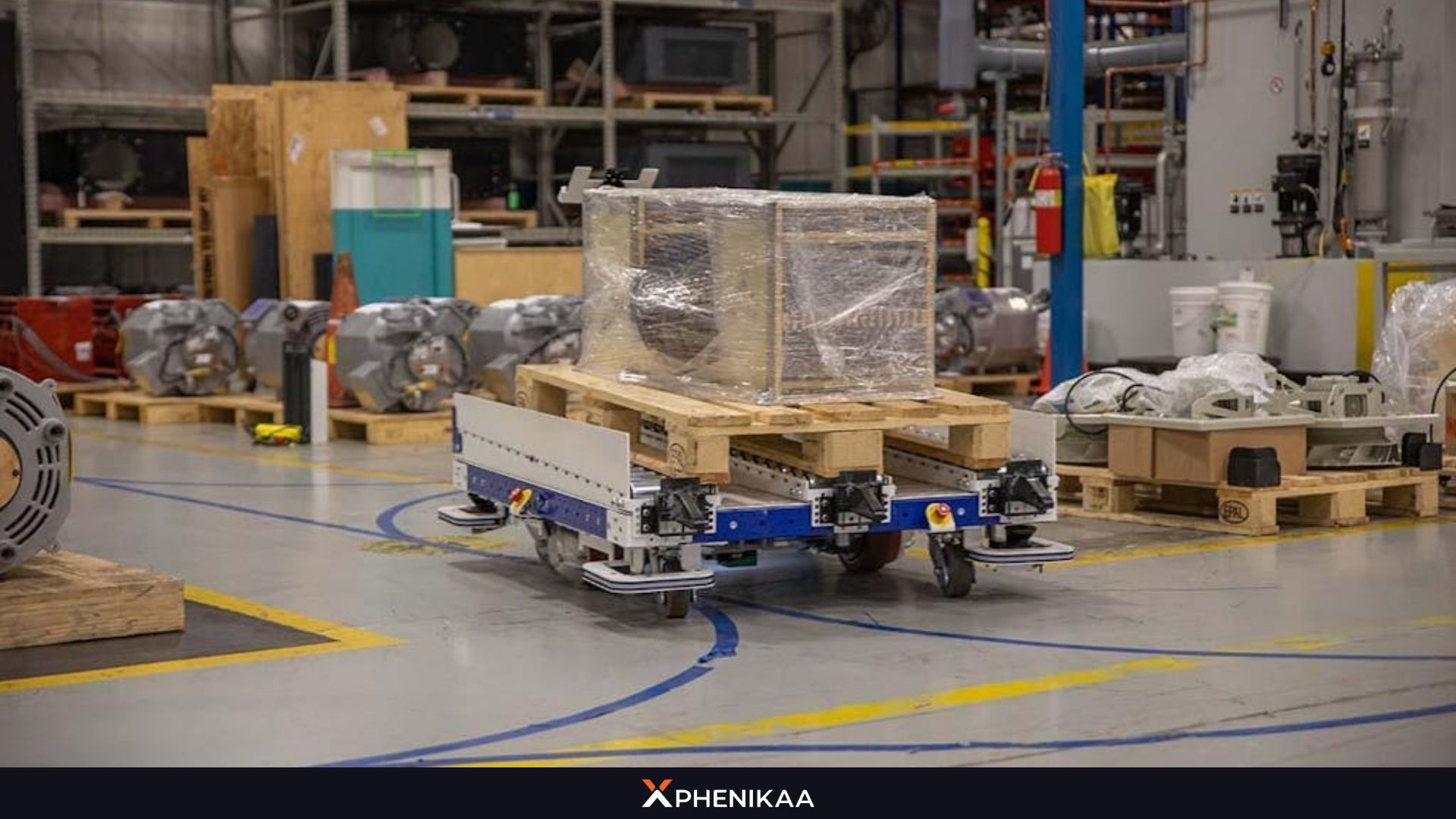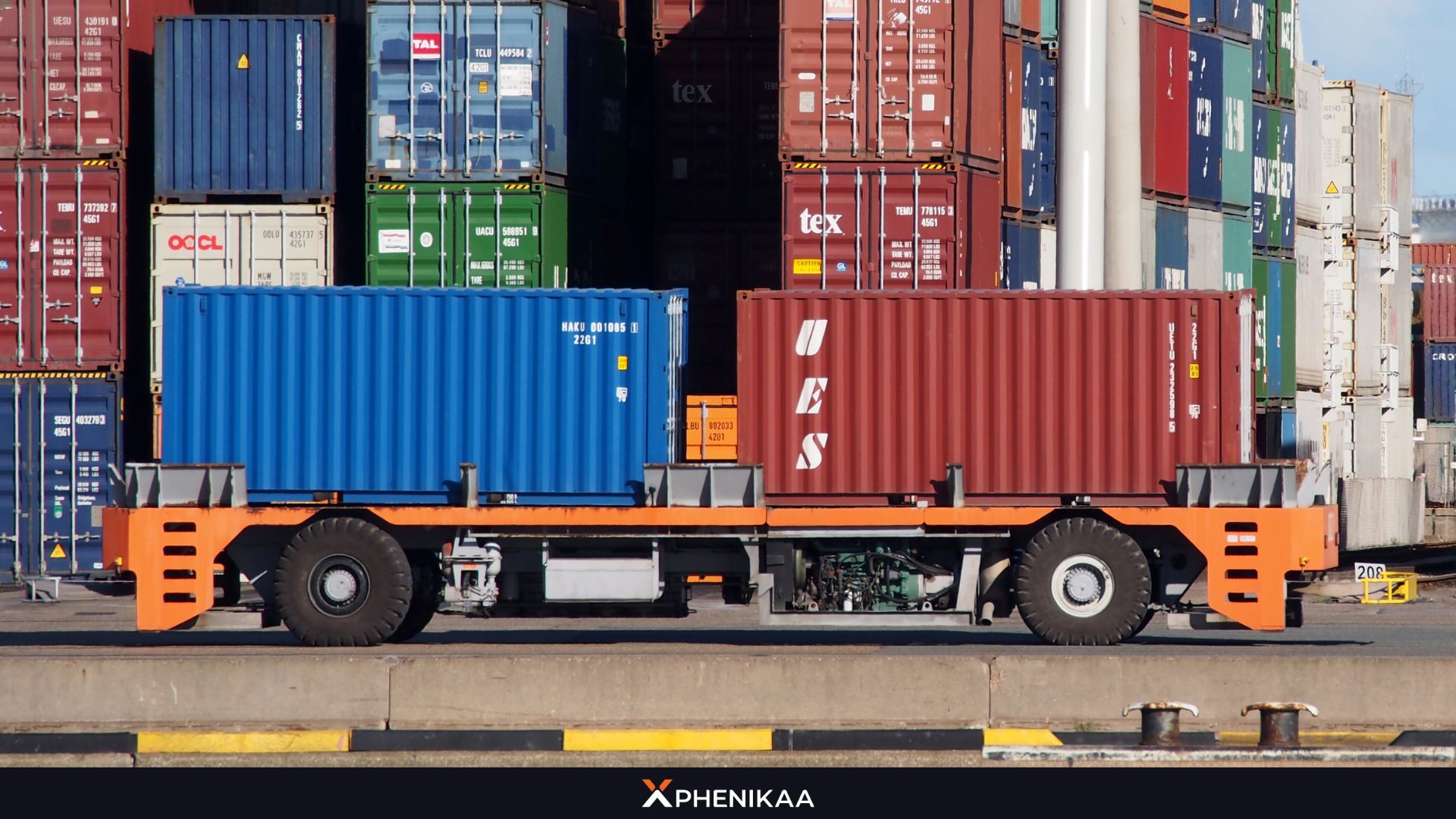The rise of automation is reshaping industries worldwide, and at the heart of this transformation are Automated Guided Vehicles (AGV). From reducing labor costs to enhancing productivity, AGV applications are unlocking new possibilities across diverse sectors. But how exactly do they contribute to modern industries? In this article, Phenikaa-X will dive into the top 05 AGV applications that are driving industrial innovation.
1. What Are AGVs and How Do They Work?
Automated Guided Vehicles (AGV) are self-operating machines that move materials without human intervention. They come in various forms, such as tow vehicles that pull carts, unit load carriers for heavy items, or forklift AGVs for lifting pallets. What makes AGVs remarkable is their navigation technology-options like laser guidance, magnetic tape, or vision-based systems allow them to follow pre-set paths or adapt to dynamic environments.

The versatility of these automated robots lies in their automation, flexibility and precision-features that make them ideal for a wide range of applications. From moving heavy machinery parts to delivering medical supplies, each type of AGVs are built to optimize workflows.
You should also check the Comprehensive Guide to Automated Guided Vehicles (AGV) for further information about these wonderful robotic technologies, shared by Phenikaa-X’s Engineers.
2. Benefits of Using AGVs in Industrial Settings
AGV robots offer a host of advantages that explain their growing popularity. First, they boost efficiency by reducing downtime and speeding up material handling. Unlike human workers, AGVs can operate 24/7 without breaks, ensuring continuous production. Second, they cut costs by minimizing reliance on manual labor and reducing errors that lead to waste.
Safety is another key benefit. AGV is equipped with sensors to avoid collisions, lowering the risk of workplace accidents – a critical factor in industries like manufacturing and logistics. Additionally, businesses can add more robot units as demand grows without overhauling their systems, with the help of AGV Software for fleet management.
These advantages shine through in the top AGV applications we’ll explore next. Whether it’s streamlining warehouse operations or enhancing assembly lines, AGV delivers measurable results. Let’s break down the 05 most impactful ways AGV is being used around the world.
3. Top 05 AGV Applications
3.1. Warehouse Automation and Logistics
One of the most transformative AGV applications is in warehouse automation. AGVs move goods between storage racks, picking stations, and shipping areas with unmatched efficiency. In massive distribution centers, they transport pallets, sort packages, and load trucks – all without human input.

Take e-commerce giants like Amazon, for example. Their warehouses rely on AGVs to fulfill orders at lightning speed, meeting the demands of same-day delivery. These vehicles excel in repetitive tasks, ensuring accuracy and reducing bottlenecks. This makes them indispensable in the age of online shopping, where millions of orders are being made worldwide each day.
3.2. Manufacturing and Assembly Lines
In manufacturing, AGV is revolutionizing how goods are produced. They transport raw materials, components, and finished products along assembly lines, ensuring a seamless workflow. Automotive plants, such as Toyota’s, use AGV for just-in-time delivery – moving parts to workers exactly when needed.

As noted by Intech Group, AGV applications in industrial production reduce manual handling and downtime. For instance, an AGV can carry heavy engine blocks across a factory floor, freeing workers to focus on skilled tasks. This not only boosts productivity but also improves workplace ergonomics.
The flexibility of AGVs allows manufacturers to reconfigure production lines quickly, adapting to new products or demand spikes. In an era of customization, this agility is priceless. AGV applications in manufacturing are paving the way for smarter, leaner factories.
3.3. Healthcare and Hospital Logistics
AGV applications are not limited to industrial settings, as they are making waves in healthcare too. In hospitals, AGV is very supportive in delivering medical supplies, meals, linens and even hazardous waste, reducing the burden on staff. Large facilities use them to transport sterilized equipment between operating rooms and storage areas.

This application enhances hygiene by minimizing human contact with sensitive items. AGV Network highlights how AGV in healthcare improves efficiency, allowing nurses and doctors to prioritize patient care over logistics. For example, an AGV can navigate hospital corridors to deliver medication on schedule, ensuring timely treatment.
3.4. Food and Beverage Industry
The food and beverage sector is another area where AGV applications shine. AGVs handle raw ingredients, packaging materials, and finished goods, ensuring smooth operations in processing plants. In cold storage facilities, they transport temperature-sensitive products like dairy or frozen goods without compromising quality.

Hygiene is critical in this industry, and AGVs meet strict standards by reducing human interaction with food items. For instance, a brewery might use AGVs to move kegs to loading docks efficiently, which are always known for being heavy for humans to work on their own.
By automating repetitive tasks, AGV applications in food processing save time and labor while maintaining consistency. This makes them a perfect fit for an industry under pressure to deliver safe, high-quality products.
3.5. Smart Ports and Material Handling
Finally, AGV applications are transforming smart ports and large-scale material handling. In some ports around the world, like Rotterdam, AGV moves containers between ships, storage yards and trucks with precision. They handle heavy loads – sometimes weighing tons – while navigating complex layouts.

ResearchGate’s survey on smart warehouse systems highlights how AGV increases throughput and reduces congestion in ports. By automating cargo transport, they minimize delays and improve turnaround times. This is critical for global trade, where efficiency drives profitability.
Beyond ports, AGV are used in airports and construction sites for similar heavy-duty tasks. AGV applications in material handling demonstrate their strength and adaptability, making them a cornerstone of modern logistics.
Automation technologies are slowly taking part in people’s daily life. It is easy to see robots appear around you, like service bots at restaurants, vending machines,… creating a trend in many other industries. These trends suggest that AGV applications will only grow in scope and impact, offering businesses new ways to innovate and compete.
Conclusion
From warehouses to hospitals, the top 05 AGV applications – warehouse automation, manufacturing, healthcare logistics, food processing, e-commerce fulfillment, and smart ports – are revolutionizing how industries operate. These applications highlight the power of AGVs to boost efficiency, cut costs, and improve safety. As technology evolves, their role will only expand, offering endless possibilities for businesses worldwide.
Phenikaa-X is one of the best AGV and robotic solutions providers in the Asia and we are now shipping worldwide. Contact us today to learn more about integrating AGVs into your business:
- Facebook: https://www.facebook.com/phenikaa.x
- Hotline: (+84) 904530545
- Email: contact@phenikaa-x.com

